When the swamp gas clears…and the weather balloons are safe in their weather-station beds …and all the super-secret spy planes have spun their alley-oops and jittered their non-ballistic shuffles through the clouds for the night…and you’re on some wide stretch of desert sand somewhere, staring up in a clear, black sky…Sometimes you might imagine…
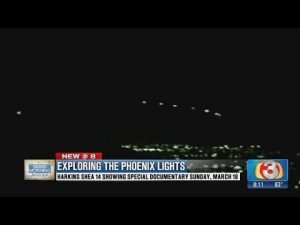
“…going live to Peter Davenport. Strange things are happening in the skies above Phoenix tonight. Peter we’re getting reports that this object is a mile wide and moving right over the downtown area.”
“That’s right, Art. We’re tracking these lights all the way across the state. It’s incredible. We’ve had sightings in Prescott, in Wickenburg…obviously this UFO is moving from the northwest to the southeast at an incredible rate of speed.”
“OK, Peter…that’s Peter Davenport from the UFO Center with a huge story tonight. Lights over Phoenix and we don’t know what they are. This is Coast-to-Coast, I’m Art Bell and we’ll be right back.”
One of the Zephyr’s biggest brushes with fame came in 1999, when my husband Jim published a piece titled “Saved by the (Art) Bell,” in which he declared his admiration for the late night Coast-to-Coast AM radio program with the wide open mind toward aliens, vampires, time travelers, and earnest offbeats of all flavors. Art Bell found the piece and discussed it on-air, and the ensuing traffic to the Zephyr site nearly blew out our bandwidth.
In his article, Jim described how he first tuned into the program on the night of the famous “Phoenix Lights” and heard the broadcast above.
Later, the story of the “Phoenix Lights” was probably solved (though who can be sure?) The Maryland Air National Guard was in Arizona for their winter training, and they had been dropping flares from a squad of A-10 fighters. But it was too late for Jim, who was now hooked on Art Bell, and went to sleep every night for years to the lulling kookiness of Bell and his guests. One on-air conversation Jim likes to remember went something like this:
“Yeah…Art? Is that you?”
“Yes it’s me. Turn down your radio sir.”
“Oh…yeah. Ok. Art this is Larry in Orlando, Florida. My wife and I have been taken on board an alien space craft several times down here. About every day this week for sure.”
“Really? Now tell me sir, can you say if it’s a Pleidian craft? A delta-wing? Or something else?”
“Well…I don’t…let me ask the wife.”
“No that’s ok. You say you’ve been up every day this week?”
“Well, Art, I have. But the wife finally told these people that she just couldn’t go flyin’ over south Florida all the time. You know…she has the washin’ to do and the like.”
You have to ask, is this caller nuts? Have he and “the wife” concocted the story out of whole cloth? Or have they honestly been buzzing around the Everglades in an extraterrestrial craft? Who knows. And that’s the point. Or maybe the point is, who cares? Either way, it’s fun to think about.
There’s something about the clear, dry starry skies west of the Hundredth Meridian in particular that beg for a closer look. They’re so BIG! Or maybe it’s the intense quiet of the air that blows unobstructed over miles of empty, uninhabited ground that makes a man feel more vulnerable to his imagination. It’s no coincidence that so many of the most puzzling brushes with extraterrestrial life occurred in the desert Southwest. Sightings of disks over White Sands, New Mexico in 1949 and nocturnal lights over Nellis Air Force Base in Nevada in 1968. Close encounters in Levelland, TX in ’57, the Apache-Sitgreaves National Forest in Arizona in ’75, and the desert roads outside Socorro, NM in ’64. People have seen some odd stuff out there.
One of the best-documented cases was that of Navy Chief Warrant Officer Delbert Newhouse, who was on vacation with his family on July 2nd, 1952 when he spotted a series of strange disks in the sky over Tremonton, Utah. The Naval Officer pulled his car to the side of US 30 and watched as the flying objects danced in the atmosphere. Stunned, it took him a moment to retrieve his Bell & Howell movie camera from the rear of the car and to set it up to start filming. Still, he managed to capture the disks clearly on forty seconds of Kodachrome daylight movie film, though they had moved farther away from him, and in the video they are seen grouping and forming patterns in the sky, cycling around each other.
He sent his footage to Hill Air Force Base in Ogden, Utah where it proceeded to baffle every officer who watched it—first, in Ogden, and then at the Air Force Photo Reconnaissance Laboratory and the Naval Photographic Interpretation Center. The footage was described, in the Air Force’s “Project Blue Book” UFO research files as “possibly the best documentary evidence yet obtained of unidentified flying objects.”
J Allen Hynek, the primary scientific consultant to “Project Blue Book”, pointed to yet another mysterious case in the desert as his “Rosetta Stone”. The case of Lonnie Zamora, an upright and unexceptional police man, who in 1964 chased a speeding car outside Socorro, New Mexico and found himself in a Close Encounter of the Third Kind.
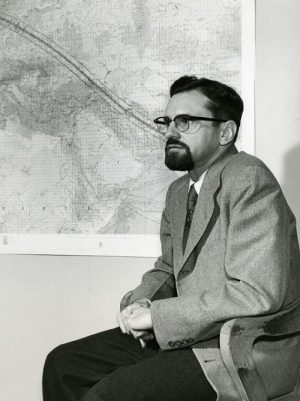
Hynek famously developed the three-tiered classifications for UFO sightings—given popular notoriety when they provided the title for Stephen Spielberg’s film “Close Encounters of the Third Kind.” (Hynek even has a small role.) The categories are as follows: in a Close Encounter of the First Kind, a person reports seeing a UFO, but there is no interaction between the UFO and the earth. In a Close Encounter of the Second Kind, the witness observes a physical effect from the UFO—headlights dimming, burned vegetation. And finally, in a Close Encounter of the Third Kind, the observer of the UFO makes some observation of “occupants” within or around the UFO.
Police Officer Zamora was chasing a black Chevy down the road outside Socorro when he spotted a flash of light to the southwest. He gave up his chase and turned off a side road to investigate the flame. As he reached the crest of a hill, he saw a “shiny type object…It looked, at first, like a car turned upside down. Thought some kids might have turned over. Saw two people in white coveralls very close to the object. One of these persons seemed to turn and look straight at my car and seemed startled—seemed to jump quickly somewhat.”
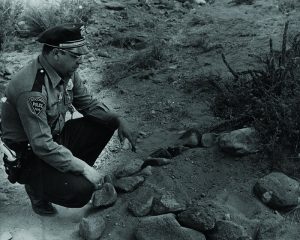
Zamora drove on toward the craft, and when he reached it, the two persons had disappeared. Also, he was struck by a symbol painted on the side of the object. He radioed the station, made a sketch for himself of the strange painted symbol, and walked toward the object. From J Allen Hynek’s “The UFO Experience”:
To his astonishment [Zamora] found himself looking down into a shallow gully at an egg-shaped metallic craft resting on legs extended from the craft. He was then less than 150 feet from the object, close enough to see a strange insignia on the side of the craft. Loud sounds from the interior of the craft caused Zamora to seek shelter as rapidly as he could. Glancing back over his shoulder at the craft, he saw it rise vertically and take off horizontally, disappearing shortly thereafter in the direction of Six Mile Canyon”
Lonnie had already radioed for help. When Sergeant Chavez arrived, he found Zamora at the site.
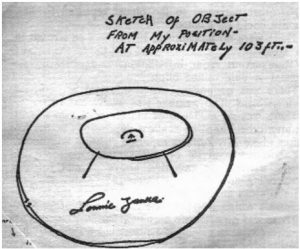
“What’s the matter, Lonnie? You look like you’ve seen the devil.”
“Maybe I have,” Zamora responded.
The Air Force searched exhaustively for some reason to disbelieve Zamora’s story—not to mention the multiple other accounts of strange flashes of light spotted near Socorro that evening—but they were stumped. As Hynek wrote in his notes, “Zamora is an unimaginative cop of an old Socorro family, incapable of hoax, and pretty sore at being regarded as a romancer.” Later, he described Zamora in a letter: “The guy doesn’t drink, cavort with women, or recite poetry. He captures speeders.” The case was left unexplained.
(As a sidenote, my husband Jim in Utah decided at this point to re-create the symbol from Zamora’s alien craft with rocks in front of his cabin. Hoping, apparently, for a ride…)
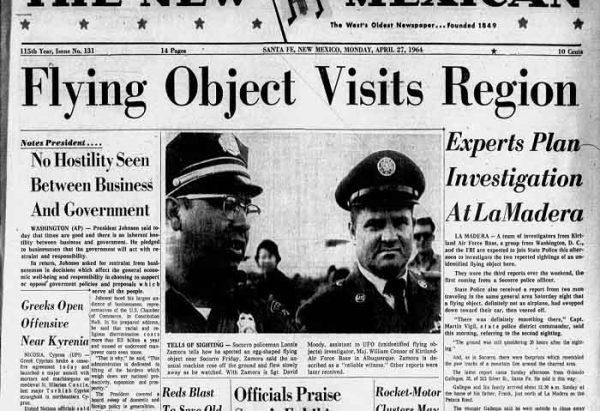
And then, in 1975, a UFO encounter in the mountains of Arizona shook the credulity of the entire nation. A young logger named Travis Walton had been clearing brush in the Apache-Sitgreaves National Forest with six of his coworkers. They were driving out from the forest when all seven men spotted strange lights through the trees. They rounded a curve in the road and suddenly, they all saw a “brilliantly-lighted object,” as Hynek described it. All the men froze, save for Walton, who ran out toward it.
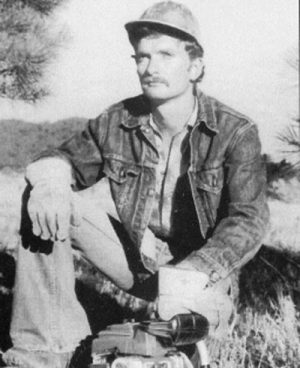
The men recounted later that Travis was struck down by a bolt of blue light. The sight completely terrified his friends, who ran away. When they returned to the site, perhaps 10 minutes later, the lighted object was gone. And so was Travis Walton.
Travis Walton was missing for nearly five days before he suddenly reappeared along a nearby road. He called his brother-in-law from a gas station, and was discovered, collapsed in the phone booth, by his brother and brother-in-law. He claimed he was only conscious of having been away for two hours. (If this sounds familiar, you may have seen the film Fire in the Sky, based on Walton’s experience.) Later, Walton described a mind-beggaring encounter with large-headed aliens with mesmerizing eyes, who flew him into space before rendering him unconscious for the duration of the experience. The group got involved in hypnotherapy, and eventually got mixed up with the National Enquirer, which damaged their credibility in the minds of serious UFO-watchers. But, to this day, no one has actually found another explanation for the disappearance of the young logger and the identical stories told by his six co-workers.
As J Allen Hynek wrote in the Introduction for his 1975 book The Edge of Reality: A Progress Report on Unidentified Flying Objects, “The UFO phenomenon calls upon us to extend our imaginations as we never have before, to think things we have never dared think before – in short to approach boldly the edge of our accepted reality and, by mentally battering at these forbidding boundaries, perhaps open up entirely new vistas.” His thoughts echo those of another dreamy scientist who looked to the Western skies for signs of extraterrestrial life. Eighty-seven years earlier, Percival Lowell wrote in The Soul of the Far East:
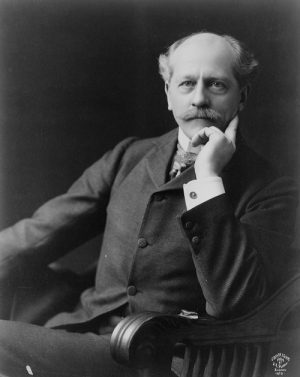
“In those bright particular stars—which the little girl thought pinholes in the dark canopy of the sky to let the glory beyond shine through—we are finding conditions of existence like yet unlike those we already know. To our groping speculations of the night they seem, as we gaze on them in their twinkling, to be winking us a sort of comprehension. Conditions may exist there under which our wildest fancies may be commonplace facts…”
Percival Lowell cemented his place in the history of the Western United States while it was still largely undeveloped territory. He chose Flagstaff, Arizona for the site of his magnificent Lowell observatory, from which he would illuminate the stars and planets—and particularly the planet Mars—for the benefit of scientific discovery.
Lowell was a lifelong eccentric. He was born in 1855 to the prominent Lowell family in Boston, and one of his sisters was the famously unconventional poet Amy Lowell. In an obituary for Amy Lowell, journalist Heywoud Broun wrote, “She was upon the surface of things a Lowell, a New Englander and a spinster. But inside everything was molten like the core of the earth… Given one more gram of emotion, Amy Lowell would have burst into flame and been consumed to cinders.” The same could be said of her star-bedazzled brother, substituting the word “curiosity,” perhaps, in place of “emotion.” He traveled extensively throughout Asia in his youthful career and took a diplomatic post in Korea in the early 1880s. Then, Lowell had the fortune to stumble across the writings of an Italian astronomer named Giovanni Schiaparelli, who had observed through his telescope some very peculiar striations on the surface of Mars. Schiaparelli called these striations “canali” or “channels,” which was mistranslated into English as “canals.” And thus was born Lowell’s fascination with Martian agriculture.
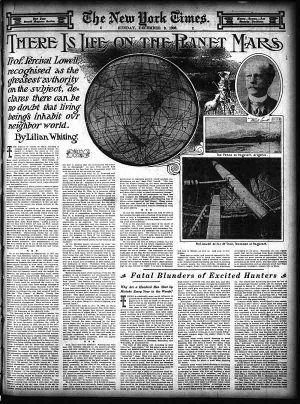
“Amid the seemingly countless stars that on a clear night spangle the vast dome overhead,” Lowell wrote for the Atlantic Magazine in 1895, “there appeared last autumn to be a new-comer, a very large and ruddy one, that rose at sunset through the haze about the eastern horizon. That star was the planet Mars…Large as he then looked, however, he is in truth but a secondary planet traveling round a secondary sun; but his interest for us is out of all proportion to his actual size or his relative importance in the cosmos. For that sun is our own; and that planet is, with the exception of the moon, our next to nearest neighbor in space… From him, therefore, of all the heavenly bodies, may we expect first to learn something beyond celestial mechanics, beyond even celestial chemistry; something in answer to the mute query that man instinctively makes as he gazes at the stars, whether there be life in worlds other than his own.”
Lowell first turned his enormous telescopes toward Mars in 1893, and produced detailed drawings of the planet’s canal systems. He published three books–Mars (1895), Mars and Its Canals (1906), and Mars As the Abode of Life (1908)–on the topic, and while some in the astronomical field were doubtful, others claimed to see the “canali” for themselves and the general public tended to accept his word on the matter. “There is Life on the Planet Mars” declared the cover of the New York Times on December 9th, 1906. “Professor Percival Lowell, recognized as the greatest authority on the subject, declares there can be no doubt that living beings inhabit our neighbor world.”
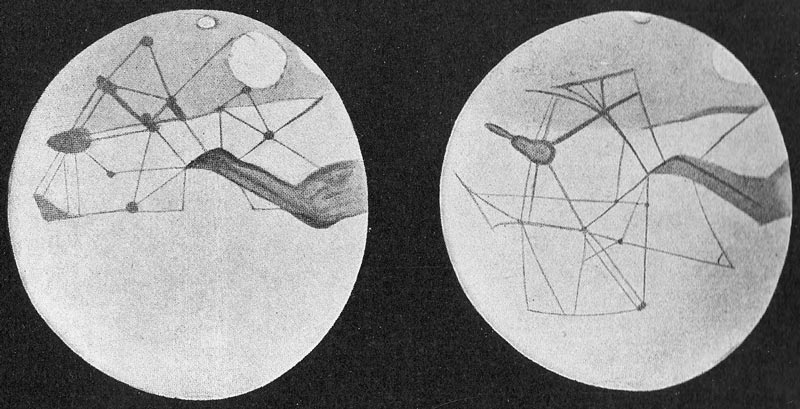
Not that he was the only respected astronomer putting forth strange ideas about our neighbor planet. The cover story for Utah’s “Salt Lake Tribune” Magazine section published October 13, 1912 announced that “…a new and exceedingly interesting theory concerning the life on Mars has been put forward by Professor William Wallace Campbell, of the great Lick Observatory, California. He suggests that all life on Mars has taken a vegetable form.”
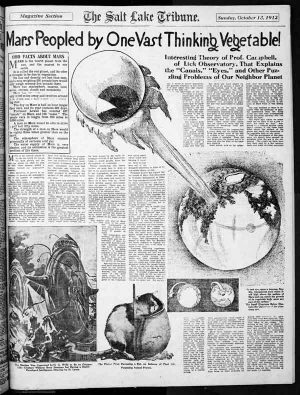
“This theory” the article continued, “is one of the most plausible that has been put forward. It has the support of all the facts about mars that have been scientifically established and it avoids many of the improbabilities involved in other theories on the same subject.”
Further, “The white spot which we sometimes see on Mars is not a pile of snow, but really an ‘eye.’ Supported on a tenuous flexible transparent column, it can raise itself miles above the surface of the planet and watch the operations of its vegetable body at any point.”
In the absence of other data, these theories held sway for decades, until NASA’s Mariner missions in the 1960s finally displayed to a disappointed American public the truth about Mars’ cratered and barren surface.
Did Lowell’s theories do us any harm in the meantime? Thanks to his Flagstaff observatory, and his boundless curiosity, we became aware of the existence of Pluto, beyond the shadows of the last known planets. And his descriptions of Mars inspired the writings of H.G. Wells and other giants of Science Fiction. Asked by a college reporter why he was so “preoccupied” with Mars, Ray Bradbury responded: “Oh, I think because it’s closest to us. You grow up with the romance of Mars. When I was a kid, some of the earliest clear photographs of Mars were being published from the Lowell Observatory in Arizona. Since it’s the nearest planet, and we know, we’ve always had this feeling that someday, if we went anywhere, it would be to the moon and then to Mars. That’s the way it’s turning out. We’ll be landing there in a few years now…”
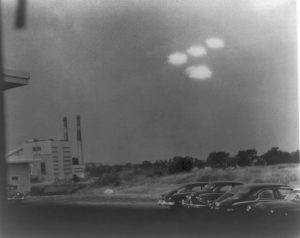
Curiosity begets creativity. And a creative mind is not only more prone to discover fact, but also to take pleasure in the great unknowable mystery of it all. In the first chapter of “The UFO Experience,” J Allen Hynek recalls the words of the great quantum physicist Erwin Schrodinger, who wrote, ““The first requirement of a scientist is that he be curious. He should be capable of being astonished and eager to find out.”
And you have to ask yourself, with that criteria in mind, what organization has been more ardent in the pursuit of science than wee-hours radio’s Coast-to-Coast AM?
The late Art Bell retired from his Pahrump, Nevada studio a few times over the years, and officially passed hosting duties to George Noory in 2003. Many listeners feel the show has never since matched the fantastical pitch of Bell’s earlier programs. But, even now, Coast-to-Coast still rings out over the airwaves from more than 600 stations across the U.S., providing company for lonesome truckers as they traverse the quiet roadways, and keeping awake sleepy travelers on interstate highways, and soothing restless insomniacs who maintain a nightly date with their bedside radio. Some of the listeners might be asking themselves, as my husband Jim did, “Is Art Bell nuts and am I a fool for listening?”
But if dreamers are fools, then at least they make for pleasurable company. As the French astronomer and devoted spiritualist loony Camille Flammarion wrote in 1880:
“What intelligent being…can look at the jagged, silvery lunar crescent trembling in the azure sky, even through the weakest of telescopes, and not be struck by it in an intensely pleasurable way, not feel cut off from everyday life here on earth and transported toward that first stop on the celestial journeys? What thoughtful soul could look at brilliant Jupiter with its four attendant satellites, or splendid Saturn encircled by its mysterious ring, or a double star glowing scarlet and sapphire in the infinity of night, and not be filled with a sense of wonder?”
Similarly, what reasonably unreasonable person, driving late at night down the long black highways of the American West, can avoid glancing up at those crystal-clear stars and wondering what’s out there? She may even shiver a little, if an old Coast-to-Coast is playing on the AM dial (please not a “shadow people” episode.) We’re the curious few, scanning for strange lights or mysterious orbs that might suddenly flash across our windshields. Hoping and fearing, in equal measure, the extraterrestrial visions that will surpass anything dreamt of in our meager philosophies.
Also, given the stressful tenor of life in America these days, a few more of us might be tempted to start putting Lonnie Zamora’s strange Alien symbol outside our homes in strategically visible places. As for Jim and me, we’ve freshened up the rocks outside the cabin.
“Watch the Skies, Everywhere! Keep Watching the Skies!”
Tonya Audyn Stiles is Publisher and Managing Editor of the Canyon Country Zephyr.
Recommended Reading:
- J. Allen Hynek. THE UFO EXPERIENCE: A Scientific Inquiry. Ballantine Books. 1972
- Mark O’Connell. The Close Encounters Man: How One Man Made the World Believe in UFOs. Dey Street Books. 2017.
- Percival Lowell. The Atlantic Monthly: “Mars. I. Atmosphere.” vol. 75 (May 1895): 594-603; “Mars. II. The Water Problem.” vol. 75 (June 1895): 749-758; “Mars. III. Canals.” vol. 76 (July 1895): 106-119; “Mars. IV. Oases.” vol. 76 (August 1895): 223-235. ONLINE HERE.
- Percival Lowell. The Soul of the Far East. Houghton Mifflin. 1888. ONLINE HERE.
- Ray Bradbury’s Lost Interview On Madmen, Writing, and Cars. Mental Floss
To comment, scroll to the bottom of the page.
Zephyr Policy: REAL NAMES ONLY on Comments!
Don’t forget the Zephyr ads! All links are hot!
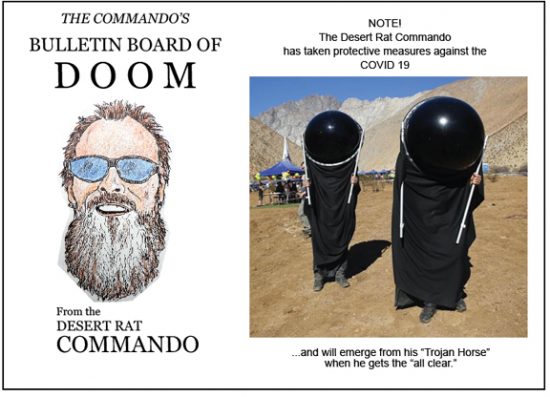
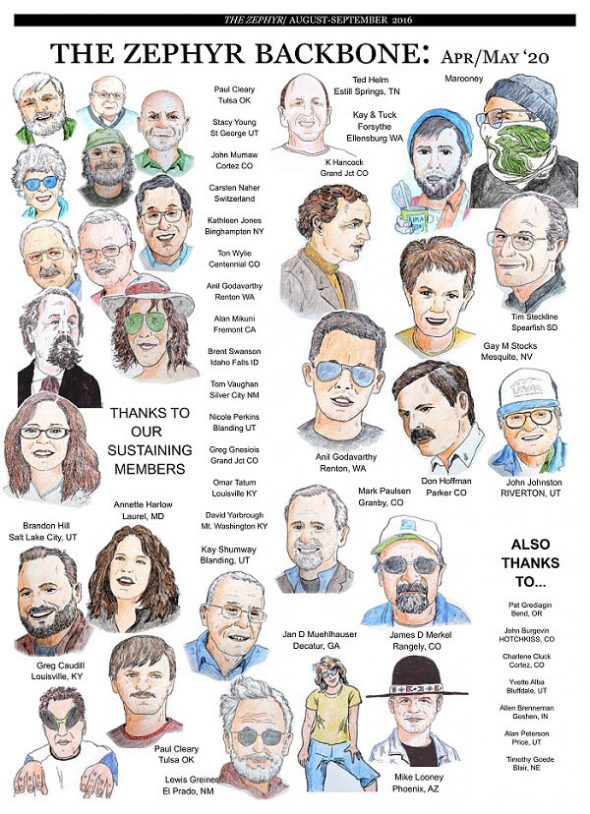

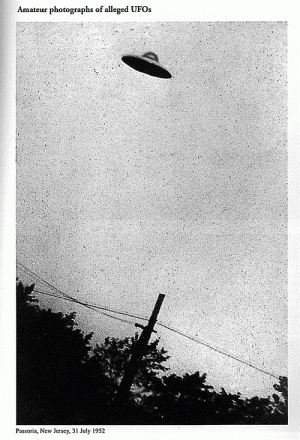







Tonya, Congrats on your new responsibilities! Nice story. Here’s a smallish follow-up tale.
I was employed some years back as a sales rep for a local Denver-based paint-manufacturing outfit. One of my responsibilities was to help make sure the touch-up paint matched during the “final” process before a house is sold. Generally this process is accomplished before the homeowner moves in, but every once in a while:
Me, contemplating: “Seems like someone already has moved in.”
Gentleman answering the door: “Welcome, are you here to match our paint for the touch-up?”
Me: “Yessir, I can set up right here in the foyer so as to not disturb you.”
He: “That’s fine, can I offer you a cup of coffee or something?”
Me: “Sure!”
As I made my way through their very cultured, maturely decorated internationally-flavored home, I was fascinated by various, but easily definable objects, such as fine vases from China, archaeological objects from Central America, lovely traditional wall art, and so on. After some discussion, I made my way back to the foyer and started to adjust the existing paint, comparing it to the wall’s color. As I proceeded, a particular rather “undefinable” piece of nicely accomplished wall art in the foyer caught my eye. The subject appeared to be a “typical” space alien, enlarged head and all.
Me: “Excuse me, sir, can you tell me about this particular original oil painting?”
His wife emitted a rather obvious groan as he asked:
“Perhaps you would like a tour of my basement?”
Me, with great excitement: “Absolutely!”
For the next many hours my host Mr. John F. Schuessler (at that time the president of the M(utual)UFON(etwork) (MUFON) introduced me to all of the outfit’s files, gifted me a signed copy of one of his books (The Cash-Landrum UFO Incident) and further fascinated me, frankly still a sceptic. We ended it this way:
Me: Mr. Schluessler, if all this is true, and the G-Men know it, than why not tell us? It would be the most significant event ever, in the history of humankind?”
Mr. Schluessler: “You seem like a guy that’s smarter than to ask such a question. Of course it is because if this information is actually revealed, people would go bat-shit crazy (I don’t think he used those exact words) — the situation, fear and loathing, etc. would be unimaginable and unmanageable.”
I left wondering if that was so. After this whole pandemic thing, and the rush for toilet paper, I now understand that Mr. Schluessler was correct. And, in case you are wondering, I did have the best job in the world.
Wow, you were quite a lucky sales rep. I would tend to agree with you, and Mr Schluessler. Thank you for the fantastic story!
Piling rocks in patterns is a win regardless of what it communicates.
Sometimes the eyewitness facts are laid aside to make room for a more exciting whale of a tale.
We had moved from Ruidoso New Mexico to Roswell where my dad was working on a now-famous ranch. I was riding in my dad’s old International pickup while he tended to his chores on the ranch, we spotted a bunch of shiny metallic materials strewn on the ground which turned out to be a weather gathering balloon. There were no Alien bodies or other unknown artifacts, just weather gathering instruments, and a balloon!
Wonderfully written piece. I won’t even try to get cutsey with words of praise. However, you are a damn good writer. I’m really enjoying the Zephyr ever since Gene Stevenson introduced me to it a few months ago. A new fan. But not new to Bluff or the Southwest.
good work ms T!
as an interstellar alien father/human mother crossbreed, i really liked this article and i really liked the comment which quoted mr. schluessler who gave his reason for your, oops, i mean our government for not revealing the existence of interstellar visits to your, oops, i mean our planet.
it’s the very same reason that my people, oops, i mean the aliens only visit and transport the occasional isolated woodcutter aboard our, oops, i mean their amazingly beautiful and oh so fast vehicles. i mean who would believe a wood cutter?
no sense in calling attention to ourselves, oops, i mean themselves and ruining it for everyone with a full on public panic. that might result in my having to return home from this lovely place i’ve grown to love. that is, uh, from new jersey back to er, uh, moab.
i have to go now and get ready for my surprise father’s day visit. it’s been light years since i’ve visited him.
Living next to Grand Staircase and near Vermilion Cliffs since before they became monuments has given me added insight into the convoluted relationship between the BLM and the Department of Defense. The airspace above these monuments and adjoining areas, including the Kaibab NF and the Navajo Nation, have been heavily used by the military-industrial complex to bring new aerospacecraft, field propulsion systems, active camouflage (electronic visual stealth), directed energy weapons, and new generations of drone technology into the “arsenal of democracy.” They are very happy to have these identified as “UFOs.” They fly the same routes through here flown by B-1s, B-52s and F-35s. A little more disconcerting is the presence on the range and in the canyons of heavily armed security forces who are in no way part of the police function of the BLM, USFS or NPS. When they choose, they appear in black military uniforms with no insignia of any kind. Insignia is also absent from their vehicles and aircraft. They carry matching black sniper rifles with black carbon fiber stocks, even when not in uniform. When something falls from the sky they move in, establish a perimeter, remove anyone in the area AT GUNPOINT, bring in helicopters and lift their target out with steel cables, generally after dark. There are hangars at a few small canyon country airports where they keep some very special light aircraft and helicopters used to conduct searches and retrieve fallen “drones.” This same group has been identified by contractors as providing security at the S-4 site in Nevada. No one at BLM knows any more than they have to, which is generally nothing. The few who know anything know enough to know that they don’t want to know any more. DOD manipulated some of the road closures and area access restrictions (including grazing leases) that started a range war fought by Kane & Garfield counties against “environmentalists” in the Agency, while the real culprits laughed from the shadows. The sweetheart land trade between BLM & Utah Trust Lands, that was secretly put together by Interior Secretary Babbit and Utah Governor Mike Leavitt, was motivated by the DOD need to clear state land out of Grand Staircase. It completely circumvented all existing laws governing such exchanges. The vast number of unrecorded Desert Archaic glyph sites that were traded to Utah to get the state out of Grand Staircase is enough to make you cry. Some of these glyphs approach 100 feet tall, and are among the largest in the Southwest.